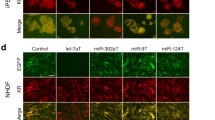Abstract
Chemically synthetic siRNA and miRNA have become powerful tools to study gene function in the past decade. Fluorescent dyes covalently attached to the 5′ or 3′ ends of synthetic small RNAs are widely used for fluorescently imaging and detection of these RNAs. However, the reliability of fluorescent tags as small RNA markers in different conditions has not attracted enough attention. We used Cy3-labelled small RNAs to explore the reliability of fluorescent tags as small RNA markers in cell cultures involving serum. A strong Cy3-fluorescence signal was observed in the cytoplasm of the cells transfected with Cy3-miR24 in the culture medium containing fetal bovine serum (FBS), but qRT-PCR results showed that little miR24 were detected in these cells. Further study demonstrated that small RNAs were degraded in the presence of FBS, suggesting that it was Cy3-RNA fragments, rather than the original Cy3-miR24, diffused into cells. These phenomena disappeared when FBS was replaced by boiled-FBS, further supporting that the Cy3-fluorescence we observed in cells in the presence of FBS could not represent the presence of intact small RNAs. These findings addressed that fluorescent tags are not reliable for small RNA transfection in the presence of serum in culture.




Similar content being viewed by others
References
Ambros V 2003 MicroRNA pathways in flies and worms: growth, death, fat, stress, and timing. Cell 113 673–676
Arroyo JD, Chevillet JR, Kroh EM, Ruf IK, Pritchard CC, Gibson DF, Mitchell PS, Bennett CF, Pogosova-Agadjanyan EL, Stirewalt DL, et al. 2011 Argonaute2 complexes carry a population of circulating microRNAs independent of vesicles in human plasma. Proc. Nat. Acad. Sci. USA 108 5003–5008
Bartel DP 2004 MicroRNAs: genomics, biogenesis, mechanism and function. Cell 116 281–297
Braasch DA, Jensen S, Liu Y, Kaur K, Arar K, White MA and Corey DR 2003 RNA interference in mammalian cells by chemically-modified RNA. Biochemistry 42 7967–7975
Caplen NJ, Parrish S, Imani F, Fire A and Morgan RA 2001 Specific inhibition of gene expression by small double-stranded RNAs in invertebrate and vertebrate systems. Proc. Nat. Acad. Sci. USA 98 9742–9747
Chen X, Ba Y, Ma L, Cai X, Yin Y, Wang K, Guo J, Zhang Y, Chen J, Guo X, et al. 2008 Characterization of microRNAs in serum: a novel class of biomarkers for diagnosis of cancer and other diseases. Cell Res. 18 997–1006
Chiu YL and Rana TM 2003 siRNA function in RNAi: a chemical modification analysis. RNA 9 1034–1048
Choung S, Kim YJ, Kim S, Park HO and Choi YC 2006 Chemical modification of siRNAs to improve serum stability without loss of efficacy. Biochem. Biophys. Res. Commun. 342 919–927
Czauderna F, Fechtner M, Dames S, Aygun H, Klippel A, Pronk GJ, Giese K and Kaufmann J 2003 Structural variations and stabilising modifications of synthetic siRNAs in mammalian cells. Nucleic Acids Res. 31 2705–2716
Dalby B, Cates S, Harris A, Ohki EC, Tilkins ML, Price PJ and Ciccarone VC 2004 Advanced transfection with Lipofectamine 2000 reagent: primary neurons, siRNA and high-throughput applications. Methods 33 95–103
Duxbury MS and Whang EE 2004 RNA interference: a practical approach. J. Surg. Res. 117 339–344
Elbashir SM, Harborth J, Lendeckel W, Yalcin A, Weber K and Tuschl T 2001a Duplexes of 21-nucleotide RNAs mediate RNA interference in cultured mammalian cells. Nature 411 494–498
Elbashir SM, Lendeckel W and Tuschl T 2001b RNA interference is mediated by 21- and 22-nucleotide RNAs. Genes Dev. 15 188–200
Fire A, Xu S, Montgomery MK, Kostas SA, Driver SE and Mello CC 1998 Potent and specific genetic interference by double-stranded RNA in Caenorhabditis elegans. Nature 391 806–811
Fu Y, Zhang GQ, Hao XM, Wu CH, Chai Z, Wang SQ. 2005 Temperature dependence and thermodynamic properties of Ca2+ sparks in rat cardiomyocytes. Biophysical journal. 89 2533–2541
Grunweller A, Gillen C, Erdmann VA and Kurreck J 2003 Cellular uptake and localization of a Cy3-labeled siRNA specific for the serine/threonine kinase Pim-1. Oligonucleotides 13 345–352
Guimaraes-Sternberg C, Meerson A, Shaked I and Soreq H 2006 MicroRNA modulation of megakaryoblast fate involves cholinergic signaling. Leukemia Res. 30 583–595
Harborth J, Elbashir SM, Vandenburgh K, Manninga H, Scaringe SA, Weber K and Tuschl T 2003 Sequence, chemical and structural variation of small interfering RNAs and short hairpin RNAs and the effect on mammalian gene silencing. Antisense Nucleic Acid Drug Dev. 13 83–105
Haupenthal J, Baehr C, Kiermayer S, Zeuzem S and Piiper A 2006 Inhibition of RNAse A family enzymes prevents degradation and loss of silencing activity of siRNAs in serum. Biochem. Pharmacol. 71 702–710
Lagos-Quintana M, Rauhut R, Lendeckel W and Tuschl T 2001 Identification of novel genes coding for small expressed RNAs. Science 294 853–858
Layzer JM, McCaffrey AP, Tanner AK, Huang Z, Kay MA and Sullenger BA 2004 In vivo activity of nuclease-resistant siRNAs. RNA 10 766–771
Seyhan AA 2006 RNAi: a potential new class of therapeutic for human genetic disease. Hum. Genet. 130 583–605
Acknowledgements
We thank Dr Xue-Mei Hao and Xiao-Chen Li for professional technical support, and Rong-Chang Li and Yun-Bo Guo for their help. This study was supported by the 973 Major State Basic Research Program of China (2011CB809101) and the National Natural Science Foundation of China (30730013).
Author information
Authors and Affiliations
Corresponding author
Additional information
Corresponding editor: B JAGADEESHWAR RAO
MS received 16 January 2013; accepted 22 April 2013
Corresponding editor: B Jagadeeshwar Rao
[Han J, Wang Q-W and Wang S-Q 2013 Fluorescent tag is not a reliable marker for small RNA transfection in the presence of serum. J. Biosci. 38 471–478] DOI 10.1007/s12038-013-9336-5
Supplementary materials pertaining to this article are available on the Journal of Biosciences Website at http://www.ias.ac.in/jbiosci/sep2013/supp/Han.pdf
Electronic supplementary material
Below is the link to the electronic supplementary material.
ESM 1
(PDF 252 kb)
Rights and permissions
About this article
Cite this article
Han, J., Wang, QW. & Wang, SQ. Fluorescent tag is not a reliable marker for small RNA transfection in the presence of serum. J Biosci 38, 471–478 (2013). https://doi.org/10.1007/s12038-013-9336-5
Received:
Accepted:
Published:
Issue Date:
DOI: https://doi.org/10.1007/s12038-013-9336-5




